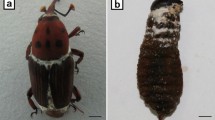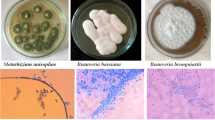Abstract
Entomopathogenic fungi (EPFs) are a significant group of insect pathogens that are used as microbial insecticides with distinct physiological mechanisms of pathogenicity. During our survey in the middle of March 2020 to early October 2022 on natural EPF as a biological control agent of the longhorn beetle (LHB) Osphranteria coerulescens, new isolates of EPFs were found on LHB larvae in apple orchards of Dargaz, Razavi Khorasan province, Iran. The nBLAST results of this these indigenous isolate indicated the highest similarity to Cladosporium sp. (Ascomycota: Davidiellaceae) with ON307222.1 access number and for EF-1α indicated the highest similarity to Cladosporium sp. with MH724951.1 access number. To assess the virulence of these indigenous isolates of EPF, a series of tests were conducted on the LHB larvae stages. Conidial concentrations 104, 105, 106, 107, and 108 (conidia/ml− 1) caused (10.21 ± 2.1), (23.44 ± 2.4), (28.72 ± 2.6), (33.23 ± 3.1) and (34.02 ± 2.8) % of mortality in LHB, respectively and there was no significant difference between 108 and 107 (conidia/ml−1) concentrations. The mortality results by the time showed that the process did not start until 3 days after treatment, and after that, it sped up. This research gathers new information about cryptic inhabiting larvae which shows considerable potential for this Cladosporium species to be implemented within the microbial control program of the LHB. This research is a new report isolating the pathogenicity of Cladosporium sp. on LHB. These fungal isolates have considerable potential for the microbiological control of the LHB.




Similar content being viewed by others
References
Abbott W (1925) A method of computing the effectiveness of an insecticide. J Econ Entomol 18:265–267. https://doi.org/10.1093/jee/18.2.265a
Abdel-Baky N (2000) Cladosporium spp. an entomopathogenic fungus for controlling whiteflies and aphids in Egypt. Pakistan J Biol Sci 3:1662–1667 https://doi.org/10.3923/pjbs.2000.1662.1667
Abdel-Baky NF, Fadaly HA, EI-Nagar ME, Arafat NS, Abd-Allah RH (2005) Virlence and enzymatic activities of some entomopathogenic fungi against whiteflies and aphids. J Plant Prot Pathol 30(2):1153–1167. https://doi.org/10.21608/jppp.2005.238696
Bahar MH, Backhouse D, Gregg PC, Mensah R (2011) Efficacy of a Cladosporium sp. fungus against Helicoverpa armigera (Lepidoptera: Noctuidae), other insect pests and beneficial insects of cotton. Biocontrol Science and Technology 21(12)
Becchimanzi A, Zimowska B, Nicoletti R (2021) Cryptic diversity in Cladosporium cladosporioides resulting from sequence-based species delimitation analyses. Pathogens 10(9): 1167
Behdad E (1984) Pests of fruit trees in Iran. Isfahan, Neshat press
Bensch K, Braun U, Groenewald J, Crous P (2011) The genus Cladosporium. Study Mycol 72:1–401. https://doi.org/10.3114/sim0003
Bidochka M, Kasperski J, Wild G (1998) Occurrence of the entomopathogenic fungi Metarhizium anisopliae and Beauveria Bassiana in soils from temperate and nearnorthern habitats. Can J Bot 76:1198–1204. https://doi.org/10.1139/b98-115
Campbell C, Johnson E (2013) Identification of pathogenic Fungi. Wiley, Oxford, UK. https://doi.org/10.1002/9781118520055
Castrillo L, Ugine T, Filotas M, Sanderson J, Vandenberg J, Wraight S (2008) Molecular characterization and comparative virulence of Beauveria bassiana isolates (Ascomycota: hypocreales) associated with the greenhouse shorefly, Scatella tenuicosta (Diptera: Ephydrididae). Biolgical Control 45:154–162. https://doi.org/10.1016/j.biocontrol.2007.10.010
Clifton EH, Jaronski ST, Hajek AE (2020) Virulence of commercialized fungal entomopathogens against Asian longhorned beetle (Coleoptera: Cerambycidae). J Insect Sci 20(2):1–6. https://doi.org/10.1093/jisesa/ieaa006
Dhawan M, Joshi N (2017) Enzymatic comparison and mortality of Beauveria bassiana against cabbage caterpillar Pieris brassicae LINN. Brazilian J Microbiol 48(3):522–529. https://doi.org/10.1016/j.bjm.2016.08.004
Donnell OK, Sutton D, Rinaldi M (2009) Novel multilocus sequence typing scheme reveals high genetic diversity of human pathogenic members of the Fusarium incarnatum-F. Equiseti and F. Chlamydosporum species complexes within the United States. J Clin Microbiol 47(12):3851–3861. https://doi.org/10.1128/JCM.01616-09
Doyle J, Doyle J (1987) A rapid DNA isolation procedure for small quantities of fresh leaf tissue. Phytochem Bull 19:11–15
Dubois T, Lund J, Bauer L, Hajek A (2008) Virulence of entomopathogenic hypocrealean fungi infecting Anoplophora glabripennis. Biocontrol 53:517–528. https://doi.org/10.1007/s10526-007-9112-2
El-Sawy M, Mostafa E, Ismail N (2019) Secondary metabolites of the entomopathogenic fungus, Cladosporium cladosporioides and its relation to toxicity of cotton aphid, Aphis gossypii (Glov). Int J Entomol Nematology 5:115–120
Elbanhawy A, Elsherbiny E, El-Mageed AA, Abdel-Fattah G (2019) Potential of fungal metabolites as a biocontrol agent against cotton aphid, Aphis gossypii Glover and the possible mechanisms of action. Pestic Biochem Physiol 159:34–40. https://doi.org/10.1016/j.pestbp.2019.05.013
Esmaeili M (1983) Important pests of fruit trees. Tehran, Sepehr Publishing Center
Farashiani ME, Askary H, Hoseini E (1998) Laboratory investigation on virulence of three entomopathogenic fungi against the larvae of Aeolesthes sarta (Col.: Cerambycidae). J Entomol Soc Iran 28:19–34
Faria MR, Wraight SP (2007) Mycoinsecticides and mycoacaricides: a comprehensive list with worldwide coverage and international classification of formulation types. Biol Control 43:237–256. https://doi.org/10.1016/j.biocontrol.2007.08.001
Hajek A, Huang B, Dubois T, Smith M, Li Z (2006) Field studies of control of Anoplophora glabripennis (Coleoptera: Cerambycidae) using fiber bands containing the entomopathogenic fungi Metarhizium anisopliae and Beauveria Brongniartii. Biocontrol Sci Technol 16:329–343. https://doi.org/10.1080/09583150500335962
Hajek A, Bauer L (2007) Microbial control of wood-boring insects attacking forest and shade trees. Field manual of techniques in invertebrate pathology. L. LA and K. HK, Springer, pp 505–525. Secaucus. https://doi.org/10.1007/978-1-4020-5933-9_24
Humber R (2012) Identification of entomopathogenic fungi. Manual of techniques in invertebrate pathology. L. LA, Amsterdam, Academic Press, pp 151–186
Jiang W, Peng Y, Ye J, Wen Y, Liu G, Xie J (2020) Effects of the entomopathogenic fungus Metarhizium anisopliae on the mortality and Immune Response of Locusta Migratoria. Insect 11(1):1–12. https://doi.org/10.3390/insects11010036
Karimi J, Darsouei R, Sharifi S (2017) A Bethylid wasp (Hymenoptera: Bethylidae) as a promising biocontrol agent of Rosaceous long horn beetle Ospheranteria coerulescens (Coleoptera: Cerambycidae). Entomol News 127(2):123–132. https://doi.org/10.3157/021.127.0207
Khoury YE, Noujeim E, Ravlić J, Oreste M, Addante R, Nemer N, Tarasco E (2020) The effect of entomopathogenic nematodes and fungi against four xylophagous pests. Biocontrol Sci Technol 30(9):983–995. https://doi.org/10.1080/09583157.2020.1781059
Kim J, Kim K (2008) Selection of a highly virulent isolate of Lecanicillium attenuatum against cotton aphid. J Asia Pac Entomol 11:1–4. https://doi.org/10.1016/j.aspen.2008.02.001
Kishore PV, Sekhar VC, Bhavani B, Upendhar S (2019) Cladosporium cladosporioides: a new report of parasitism on sugarcane woolly aphid, Ceratovacuna Lanigera Zehntner. J Entomol Zoological Stud 7:1122–1126
Kumar C, Jacob T, Devasahayam S, D’Silva S, Kumar N (2015) Isolation and characterization of a Lecanicillium psalliotae isolate infecting cardamom thrips (Sciothrips cardamomi) in India. BioControl 60: 363–373
Lacey L, Shapiro-Ilan D (2008) Microbial control of insect pests in temperate orchard systems: potential for incorporation into IPM. Ann Rev Entomol 53:121–144. https://doi.org/10.1146/annurev.ento.53.103106.093419
Lacey L, Grzywacz D, Shapiro-Ilan D, Frutos R, Brownbridge M, Goettel M (2015) Insect pathogens as biological control agents: back to the future. J Invertebr Pathol 132:1–41. https://doi.org/10.1016/j.jip.2015.07.009
Lee S, Yu J, Nai Y, Parker B, Skinner M, Kim J (2015) Beauveria bassiana sensu lato granules for management of brown planthopper, Nilaparvata lugens in rice. Biocontrol 60:263–270. https://doi.org/10.1007/s10526-014-9632-5
Liu H, Bauer L (2008) Microbial control of emerald ash borer, Agrilus planipennis (Coleoptera: Buprestidae) with Beauveria bassiana strain GHA: greenhouse and field trials. Biol Control 45:124–132. https://doi.org/10.1016/j.biocontrol.2007.12.008
Mannino MC, Huarte-Bonnet C, Davyt-Colo B, Pedrini N (2019) Is the insect cuticle the only entry gate for fungal infection? Insights into alternative modes of action of Entomopathogenic Fungi. J Fungi 5(2):33–43. https://doi.org/10.3390/jof5020033
Meyers J, Stephen F, Haavik L, Steinkraus D (2013) Laboratory and field bioassays on the effects of Beauveria Bassiana Vuillemin (Hypocreales: Cordycipitaceae) on red oak borer, Enaphalodes rufulus (Haldeman) (Coleoptera: Cerambycidae). Biol Control 65:258–264. https://doi.org/10.1016/j.biocontrol.2013.02.001
Mnyone LL, Kirby MJ, Lwetoijera DW, Mpingwa MW, Knols BG, Takken W, Russell TL (2009) Infection of the malaria mosquito, Anopheles gambiae, with two species of entomopathogenic fungi: effects of concentration, co-formulation, exposure time and persistence. Malar J 8(309).
Mohammadyani M, Karimi J, Taheri P, Sadeghi H, Zare R (2016) Entomopathogenic fungi as promising biocontrol agents for the rosaceous longhorn beetle, Osphranteria coerulescens. Biocontrol 61:579–590. https://doi.org/10.1007/s10526-016-9745-0
Mousavi K, Rajabpour A, Parizipour MHG, Yarahmadi F (2022) Biological and molecular characterization of Cladosporium sp. and acremonium zeylanicum as biocontrol agents of Aphis fabae in a tri-trophic system. Entomol Exp Appl 170(10):877–886. https://doi.org/10.1111/eea.13217
Narmani A, Arzanlou M, Kazemi F, Karimzadeh R (2016) First report of Cladosporium cladosporioides on Alfalfa weevil larvae (Hyperapostica) in the world. Proceedings of 22th Iranian Plant Protection Congress. Tehran, Iran: 679
Ranjbar Aghdam H, Marzban R, Mafi-Pashakolaei S, Sedighi L (2023) Study on the possibility control of box tree moth,Cydalima Perspectalis (Lepidoptera: Crambidae) using microbial, organic and low risk insecticides. J Entomol Soc Iran 43(1):23–29. https://doi.org/10.52547/JESI.43.1.4.
Reay S, Hachet C, Nelson T, Brownbridge M, Glare T (2007) Persistence of conidia and potential efficacy of Beauveria bassiana against pinhole borers in New Zealand southern beech forests. For Ecol Manag 246:232–239. https://doi.org/10.1016/j.foreco.2007.04.005
Scholthof K (2007) The disease triangle: pathogens, the environment and society. Nat Rev Microbiol 5:152–156. https://doi.org/10.1038/nrmicro1596
Shaker N, Ahmed G, Ibrahim H, El-Sawy M, Mostafa M, Ismail H (2019) Secondary metabolites of the entomopathogenic fungus, Cladosporium cladosporioides and its relation to toxicity of cotton aphid, Aphis gossypii (Glov). Int J Entomol Nematology 5:115–120
Shanley R, Keena M, Wheeler M, Leland J, Hajek A (2009) Evaluating the virulence and longevity of non-woven fiber bands impregnated with Metarhizium anisopliae against the Asian longhorned beetle, Anoplophora Glabr Ipennis (Coleoptera: Cerambycidae). Biol Control 50:94–102. https://doi.org/10.1016/j.biocontrol.2009.03.013
Sharifi S, Javadi I, Chemsak JA (1970) Biology of the Rosaceae branch borer, Osphranteria coerulescens (Coleoptera: Cerambycidae). Ann Entomol Soc Am 63:1515–1520. https://doi.org/10.1093/aesa/63.6.1515
Shimazu M, Zhang B, Liu Y (2002) Fungal pathogens of Anoplophora glabripennis (Coleoptera: cerambycidae) and their virulences. Bull Forestry for Prod Res Inst 1:123–130
Tamura K, Stecher G, Peterson D, Filipski A, Kumar S (2013) MEGA6: Molecular Evolutionary Genetics Analysis version6.0. Mol Biol Evol 30:2725–2729. https://doi.org/10.1093/molbev/mst197
Tanada Y, Kaya H (1993) Insect pathology. Academic, San Diego, CA
Thakur A, Singh V, Kaur A, Kaur S (2014) Suppression of cellular immune response in Spodoptera litura (Lepidoptera: Noctuidae) larvae by endophytic fungi Nigrospora oryzae and Cladosporium uredinicola. Ann Entomol Soc Am 107(3):674–679. https://doi.org/10.1603/AN13164
Thompson JD, Higgins DG, Gibson TJ (1994) CLUSTAL W: improving the sensitivity of progressive multiple sequence alignment through sequence weighting, position-specific gap penalties and weight matrix choice. Nucleic Acids Res 22(22):4673–4680. https://doi.org/10.1093/nar/22.22.4673
Vries dG (1952) Contribution to the Knowledge of the Genus Cladosporium. PhD Dissertation, Utrecht University
White TJ, Bruns TD, Lee SB, Taylor JW (1990) Amplification and direct sequencing of fungal ribosomal RNA Genes for phylogenetics. PCR protocol, a guide to methods and appliaction. M. Innis, D. Gelfand, J. Sninsky and T. White. San Diego, Academic press: 315–322
Yu Y, Cao Y, Xia Y, Liu F (2016) Wright-Giemsa staining to observe phagocytes in Locusta migratoria infected with Metarhizium acridum. J Invertebr Pathol 139:19–24. https://doi.org/10.1016/j.jip.2016.06.009
Author information
Authors and Affiliations
Corresponding author
Ethics declarations
Conflict of interest
We don’t have any conflict of interest.
Additional information
Publisher’s Note
Springer Nature remains neutral with regard to jurisdictional claims in published maps and institutional affiliations.
Rights and permissions
Springer Nature or its licensor (e.g. a society or other partner) holds exclusive rights to this article under a publishing agreement with the author(s) or other rightsholder(s); author self-archiving of the accepted manuscript version of this article is solely governed by the terms of such publishing agreement and applicable law.
About this article
Cite this article
Farrokhzadeh, H., Sharifi, S., Eroğlu, G.B. et al. A new fungal entomopathogen has potency as a biocontrol agent of longhorn beetle larva, Osphranteria coerulescencs. Int J Trop Insect Sci (2024). https://doi.org/10.1007/s42690-024-01230-8
Received:
Accepted:
Published:
DOI: https://doi.org/10.1007/s42690-024-01230-8




